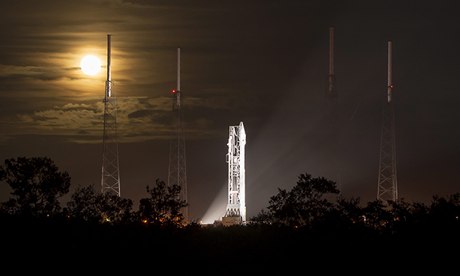LINK to live stream from WaPo: http://www.washingtonpost.com/posttv/c/live/cbf7a484-7d90-11e0-b6cc-e4e4a8a38cf0
Nasa's Maven spacecraft set for Mars mission
Maven, which will take 10 months to reach Mars, will study planet's upper atmosphere for reasons why it thinned and cooled

The Atlas V rocket carrying the Maven spacecraft sits at Cape Canaveral, Florida, prior to its expected launch. Photograph: NASA/Bill Ingalls/EPA
Nasa's newest Martian explorer is on its launch pad at Cape Canaveral in Florida, ready for its scheduled launch on Monday afternoon.
The Maven spacecraft is scheduled to blast off aboard an unmanned Atlas V rocket at 1.28pm local time, with weather forecasters predicting a 60%chance of favourable launch conditions.
Maven's mission is to study Mars' upper atmosphere. Scientists want to know why the red planet went from being warm and wet during its first billion years, to the cold and dry place it is today.
The early Martian atmosphere was thick enough to hold water and possibly support microbial life. But much of that atmosphere may have been lost to space, eroded by the sun.
"Something clearly happened," said the University of Colorado's Bruce Jakosky, the principal Maven scientist. "What we want to do is to understand what are the reasons for that change in the climate."
Maven, carrying eight science instruments, will take 10 months to reach Mars, entering into orbit around the red planet in September 2014. The mission cost has been put at $671m (£416m).
A question underlying all of Nasa's 21 Mars missions to date is whether life could have started on what now seems to be a barren world.
"We don't have that answer yet, and that's all part of our quest for trying to answer, 'Are we alone in the universe?' in a much broader sense," said John Grunsfeld, Nasa's science mission director.
Maven stands for Mars Atmosphere and Volatile EvolutioN,. It is Nasa's 21st shot at Mars. Fourteen of the previous 20 missions have succeeded, the most recent being the Curiosity rover that was launched in 2011 and landed in 2012.
Curiosity's odometer reads 2.6 miles after more than a year of roving. An astronaut could accomplish that distance in about a day on the Martian surface, Grunsfeld said. But he added that considerable technology was needed before humans ccould fly to Mars in the 2030s, Nasa's ultimate objective.
